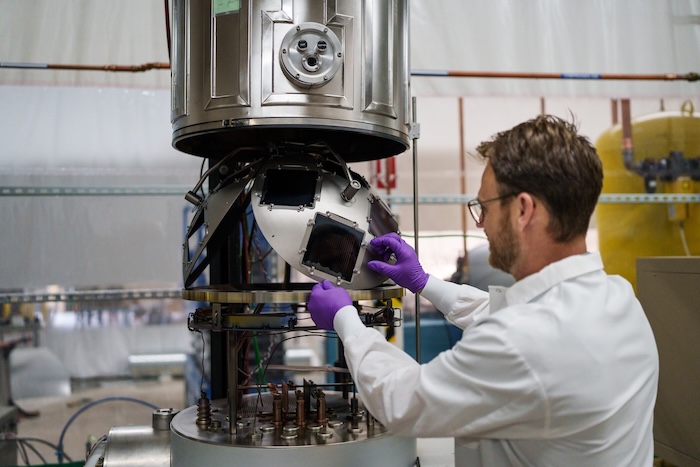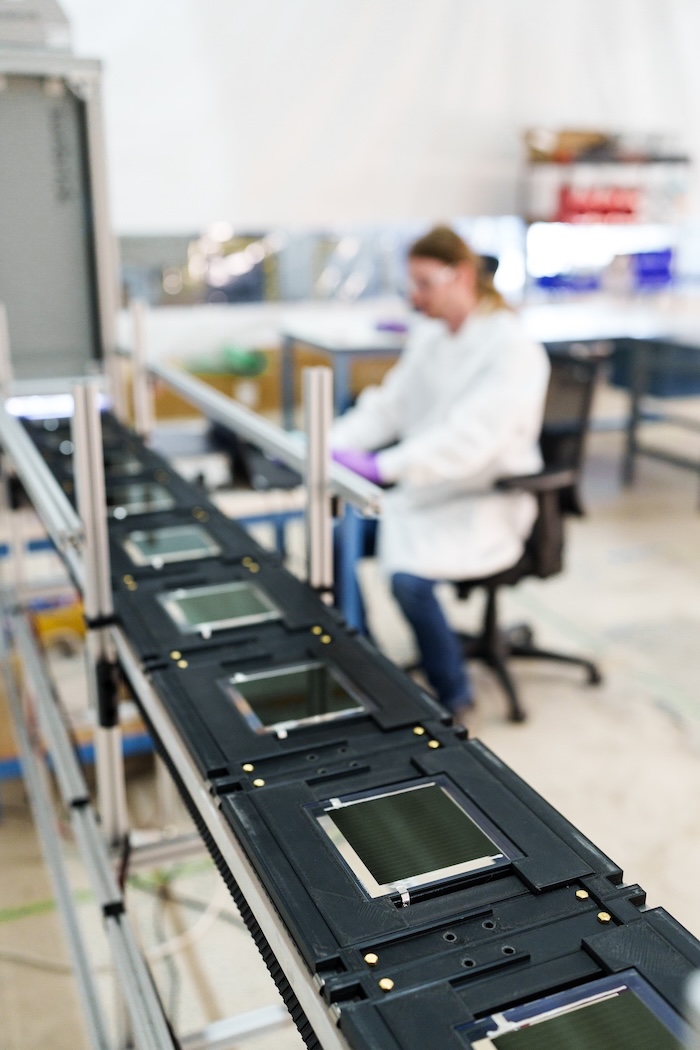Tandem PV is a company that develops and manufactures advanced perovskite-silicon tandem solar panels. Pulse 2.0 interviewed CEO Scott Wharton to gain a deeper understanding of the company.
Scott Wharton’s Background

What is Scott Wharton’s background? Wharton said:
“I’ve spent my career helping build and scale transformative tech companies, from pioneering voice over IP in the early days of the internet to reimagining hybrid work through video collaboration. Most recently, I led Logitech’s video conferencing division, growing it from a $62 million business into a billion-dollar global leader.”
“It was a fantastic run scaling Logitech’s business and helping redefine how the world conducts hybrid work during the pandemic. But when the opportunity to join Tandem PV came along, I knew I had to be a part of it. I’ve had a longstanding interest in solar.”
“Back in business school, when most of my classmates were pursuing careers in consulting and finance, I took what was then an unconventional path: a summer internship with the Solar Energy Industries Association. I was hooked. At the time, the market wasn’t ready, so I pivoted to internet communications. But I never stopped following the solar industry, always hoping I’d find my way back.”
“I was thrilled to join Tandem PV as CEO in July 2023. The company is built on groundbreaking research by Dr. Colin Bailie at Stanford, where he developed one of the first high-efficiency perovskite-silicon tandem solar cells. With roots in the Cyclotron Road accelerator at Berkeley Lab, Tandem PV is now developing next-generation solar technology that can dramatically improve efficiency while lowering costs and carbon impact.”
“What drew me to Tandem PV wasn’t just the technology – it was the team, the timing, and the mission. Our founders, Colin and Dr. Chris Eberspacher, along with a world-class bench of scientists, engineers, and operators, are working at the cutting edge of clean energy innovation. We’re scaling a platform that can help re-establish U.S. leadership in solar innovation and build a secure and sustainable energy future.“
“In many ways, this role brings my career full circle. It’s the perfect convergence of my entrepreneurial experience, leadership in scaling hardware and software businesses, and my deep passion for solar. The world needs better, faster renewable energy solutions and I’m proud to help a company that’s answering that call with urgency and innovation.”

Formation Of The Company
How did the idea for the company come together? Wharton shared:
“Tandem PV was born from our founder and CTO Dr. Colin Bailie’s PhD work at Stanford. He invented the first perovskite-on-silicon tandem cell, a novel structure that could overcome the efficiency limits of conventional silicon panels. Recognizing the commercial potential to dramatically lower the cost of solar energy, he founded Tandem PV to bring this innovation from the lab to the market.”
Favorite Memory
What has been your favorite memory working for the company so far? Wharton reflected:
“One of the things I’m most proud of is closing our $50 million Series A funding round in an incredibly tough fundraising environment. With so much investment attention focused on AI, reaching this milestone was a major achievement. This infusion of capital from leading investors like Eclipse VC, Trellis Capital and Constellation Energy is a strong vote of confidence in our technology and our team’s ability to execute. This stage of growth is often called the ‘valley of death’ in the clean energy industry, and we are proud that our technology is moving from the lab to commercial viability. We’ve also received a $5.2 million award from the U.S. Department of Energy’s Solar Energy Technologies Office (SETO) and a new $4 million grant from the California Energy Commission. What made this so rewarding wasn’t just the capital, it was the enthusiasm we heard from investors when we shared our vision. They were excited to be a part of what comes next.”

Core Products
What are the company’s core products and features? Wharton explained:
“Tandem PV is commercializing the most efficient and durable perovskite solar panel on the market.
- Efficiency: Our current panels achieve 28% efficiency, proving to be 30% more powerful than the average silicon solar panel. This performance is especially critical for AI data centers, where space and power density are essential.
- Cost savings: Our panels generate more power at a similar price per watt, dramatically reducing the levelized cost of energy (LCOE) by lowering land, labor, and balance-of-system expenses. Unlike traditional power plants that take years to build, solar farms can be deployed in months, aligning with the fast pace of AI growth.
- Durability: In the lab, Tandem PV has demonstrated the equivalent of decades of durability, ensuring long-term performance and reliability.”
Challenges Faced
What challenges has Wharton and the team faced in building the company? Wharton acknowledged:
“One of our early challenges wasn’t technical, but perception. The solar industry had long viewed perovskite as a promising material with a big flaw: instability. Early lab results dazzling on efficiency but fell short on delivering on durability creating skepticism among investors and established players.”
“Our team, particularly Colin Bailie, faced this challenge head-on. Through rigorous materials science and engineering, we discovered that precisely controlling the interface between the perovskite layer and the silicon, coupled with innovative encapsulation techniques, could dramatically enhance stability.” “It was an iterative process of trial and refinement. But we learned that it takes more than just strong data to change perceptions, it takes engineering breakthroughs, persistence and the willingness to innovate.”
Evolution Of The Company’s Technology
How has the company’s technology evolved since its launch? Wharton noted:
“Tandem PV Co-founder and CTO Colin Bailie first developed the world’s first perovskite-silicon tandem cell at Stanford University and launched the company through Activate, the U.S. Dept. of Energy startup accelerator. Since then, the biggest evolution has been scaling that lab success into large-format panels that are manufacturable at high volume while maintaining performance and durability. We are engineering a product for real-world deployment.”

Significant Milestones
What have been some of the company’s most significant milestones? Wharton cited:
“Technological Milestones: We’ve hit and exceeded our internal efficiency targets. Our current panels achieve 28% efficiency, proving to be 30% more powerful than the average silicon solar panel.
Funding: The company has raised over $87 million to date, from a mix of top-tier venture capital, strategic investors, and public grants, validating both the technology and the team.
Recognition: We received a $5.2 million award from the U.S. Department of Energy’s Solar Energy Technologies Office (SETO) and were named Best Venture in the Pre-Commercialization Track at NREL’s 2025 Industry Growth Forum.”
Customer Success Stories
When asking Wharton about customer success stories, he highlighted:
“Even ahead of mass production, the early response from top utility-scale developers has validated both our technology and our approach. Our discussions have demonstrated strong market demand and a clear path to scale.”
Funding
When asking Wharton about the company’s funding details, he revealed:
“As noted, we’ve raised over $87 million to date – a mix of venture capital, strategic investments, and grants from the U.S. Department of Energy, NSF, and California Energy Commission.”
Total Addressable Market
What total addressable market (TAM) size is the company pursuing? Wharton assessed:
“Our primary focus is the U.S. utility-scale solar market. According to the Solar Energy Industries Association, the value of the Solar Market in 2024 was $70.3 billion. The overall global market for solar panels is in the hundreds of billions and expected to reach over $1 trillion per year in the 2030s.”
Differentiation From The Competition
What differentiates the company from its competition? Wharton affirmed:
“Three things set us apart:
- Performance: Our panels offer breakthrough efficiency that significantly lowers the cost of energy.
- Proven Durability: We are demonstrating long-term reliability through rigorous lab testing and real-world field data.
- Strategic Value: We’re enabling a U.S.-based secure supply chain, something the market is increasingly demanding.”
Future Company Goals
What are some of the company’s future goals? Wharton emphasized:
“We are actively executing on plans to build our first commercial-scale manufacturing facility in the U.S. Long term, our goal is to revolutionize solar energy and help establish the U.S. as a leader in renewable energy.”
Additional Thoughts
Any other topics you would like to discuss? Wharton concluded:
“Tandem PV represents a unique opportunity. We are at the intersection of two massive trends: the insatiable energy demand of the AI revolution and the strategic imperative for U.S. energy independence. We have the technology, the team, and the commercial traction to become a leader in this new era of energy. We aren’t just developing a better solar panel; we’re building a foundational American manufacturing company for the 21st century.”


